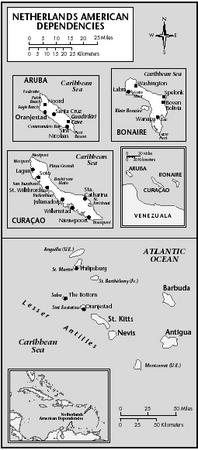Netherlands American Dependencies - Aruba
The island of Aruba is located off the north coast of South America, NW of Curaçao. It has an area of 193 sq km (75 sq mi). The land is basically flat and is renowned for its white-sand beaches. The temperature is almost constant at 27° C (81° F ); the annual rainfall averages 60 cm (24 in). The mid-1999 population was estimated at 68,675. The official language is Dutch, but Papiamento, English, and Spanish are also spoken. The religion of the majority is Roman Catholic.
There are no rivers or railways. The road system connects all major cities. There are three deepwater harbors, at San Nicolas, Oranjestad, and Barcadera. Airline connections are provided by Dutch Antillean Airlines (Antilliaanse Luchtvaart Maatschappij—ALM), Royal Dutch Airlines (Koninklijke Luchtvaart Maatschappij—KLM), and other international carriers.
In March 1983, at the Hague, the governments of the Netherlands and Netherlands Antilles agreed to grant Aruba the status of a separate state. On 1 January 1986, Aruba seceded from the Netherlands Antilles, becoming a separate member of the kingdom. In 1990, Aruba requested and received from the Netherlands a cancellation of the agreement that would have granted independence in 1996.
The head of government is a governor appointed by and representing the crown. A Council of Ministers, led by a prime minister, has executive power. The ministers are responsible to the Staten, a legislative body of 21 members elected by universal

adult suffrage for four-year terms. Cases are tried in a court of first instance and on appeal in the Joint High Court of Justice, with justices appointed by the crown. Defense is the responsibility of the Netherlands; a naval contingent is stationed on the island, and military service is compulsory.
The two principal sources of revenue for the island are tourism and oil refining. Coastal Aruba Refining Co., a subsidiary of Coastal Corp. of Houston, produces asphalt, diesel fuel, feedstock for other refineries, kerosene, and residual fuel oil at the Lago refinery. Since the refinery reopened in 1993, economic growth has surged, as the refinery provides a major source of employment and foreign exchange earnings. The currency unit is the Aruban florin (Af) of 100 cents, with a fixed exchange rate of Af1 = $0.5587 (or $1 = Af1.79) since 1986. The GDP for 1997 was US $1.5 billion, or US $22,000 per capita. The unemployment rate was 0.6% in 1996, leading to a large number of unfilled job vacancies despite recent sharp increases in wage rates.
In 1997, Aruban exports were valued at US $1.73 billion (mostly refined petroleum products), and imports at US $2.12 billion. The US and the EU are Aruba's major trading partners. There is a Central Bank of Aruba, and there are six commercial banks. The Aruba Development Bank was created in 1982 to stimulate foreign investment in service industries.
Medical care is entirely subsidized by the government; there is a modern hospital. There were 26 preprimary schools, 33 primary schools, 23 secondary schools, and 1 teacher-training college. Although education is not compulsory, the literacy rate is high (over 90%). There are 4 AM and 6 FM commercial radio stations and one television station in Aruba. There is one daily newspaper published in Dutch, one in English, and one in Papiamento. There were an estimated 22,922 telephones on the island in 1993.
Tourism is the major source of revenue. Over 500,000 tourists annually visit the island, with about half coming from the US.
Comment about this article, ask questions, or add new information about this topic: